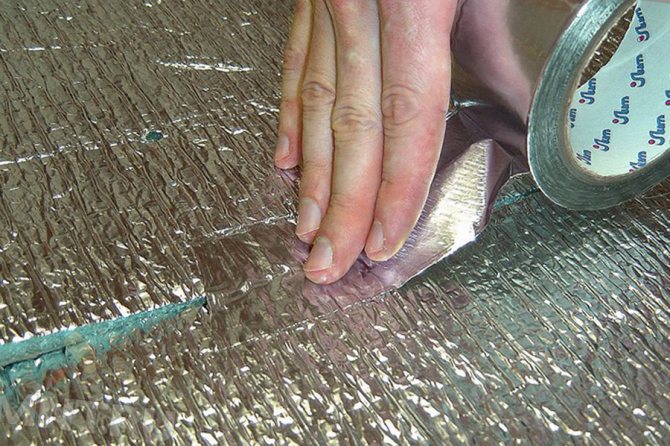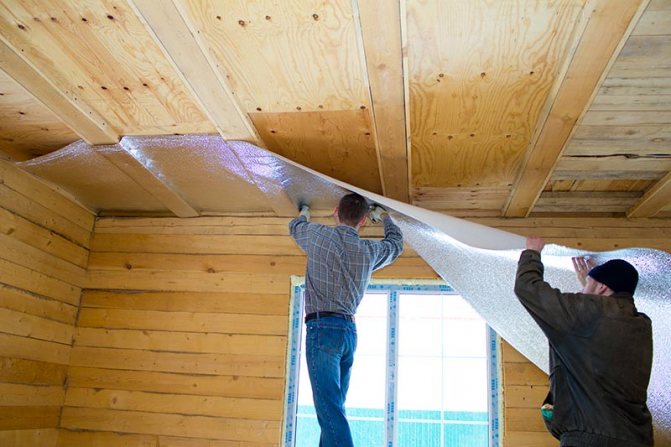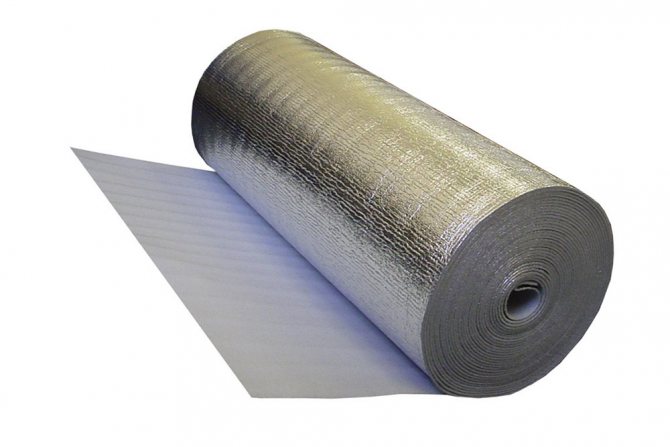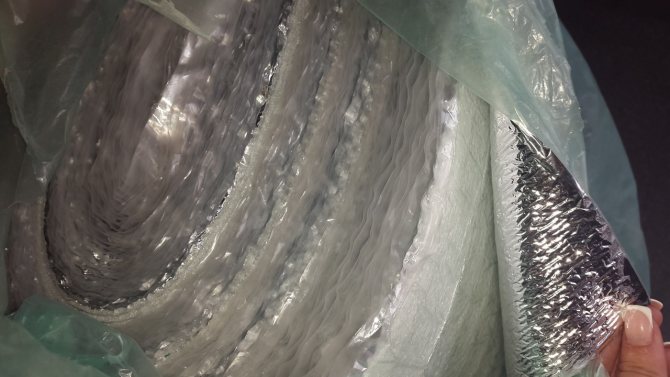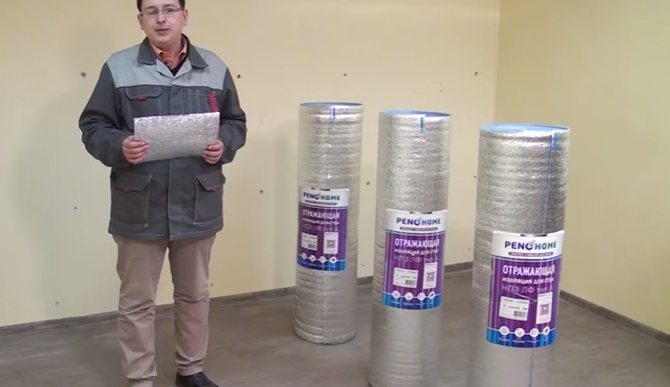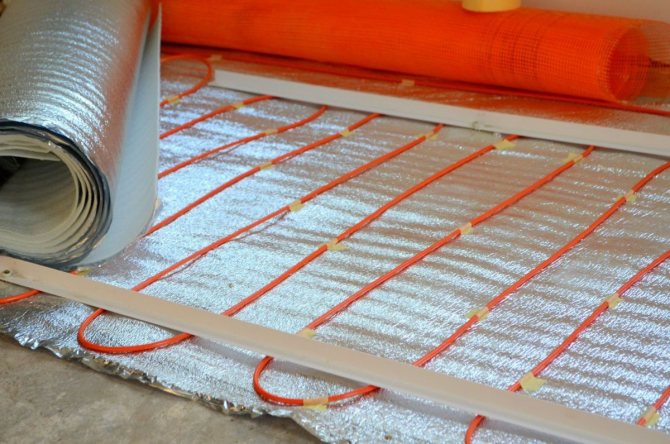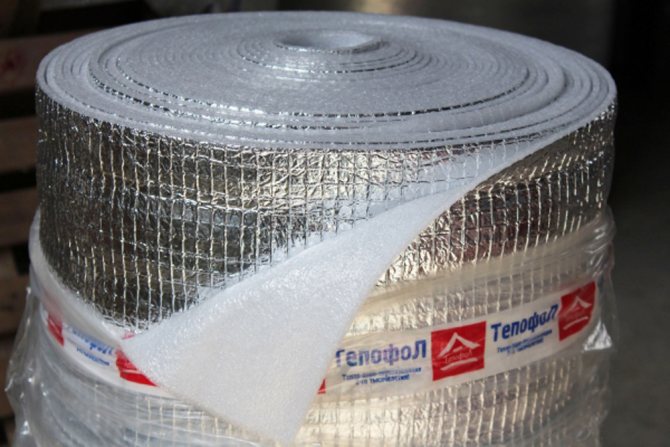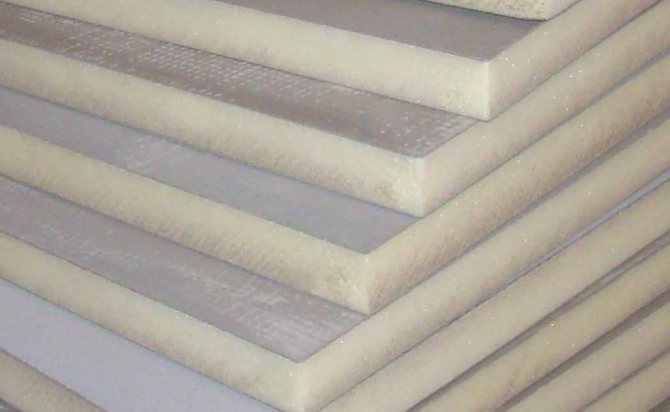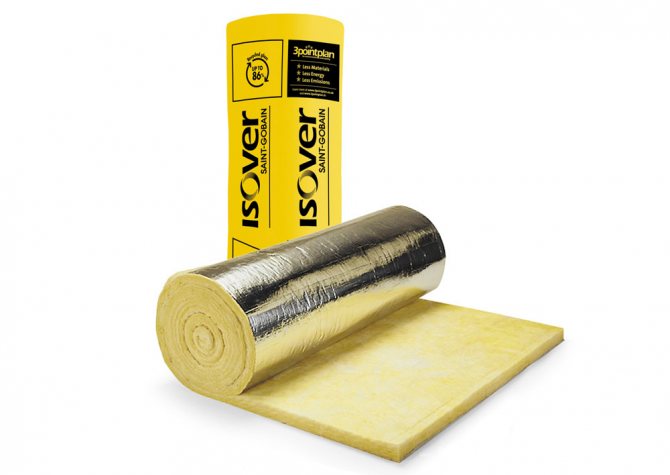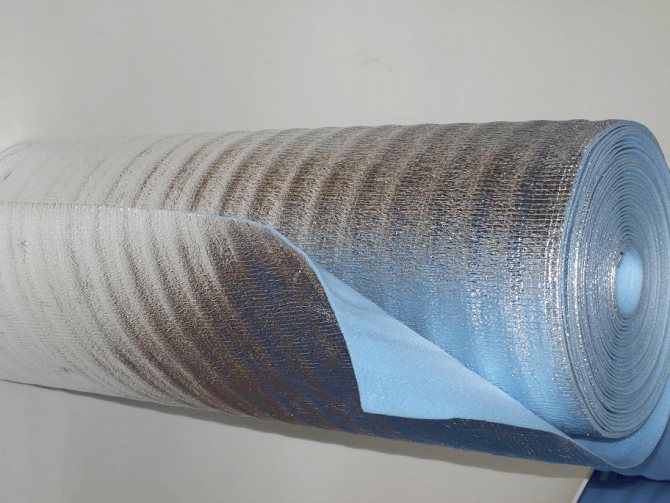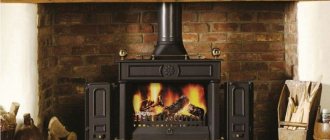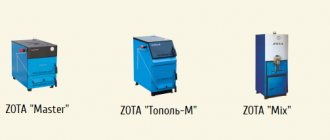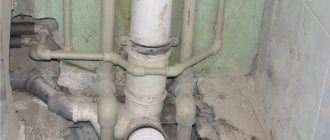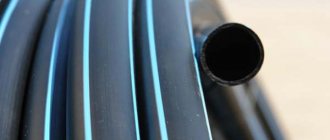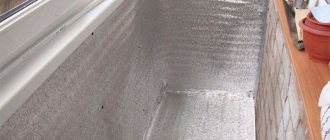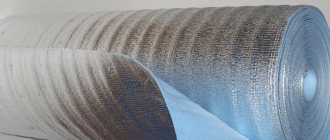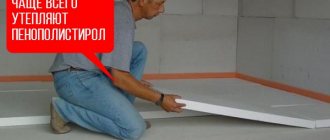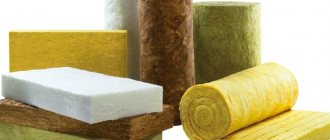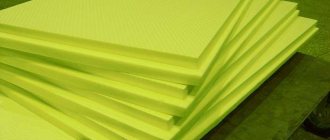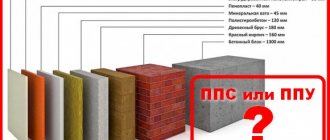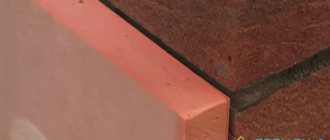Due to its technical characteristics, foil insulation for walls can be used for both indoor and outdoor use. It can be used for insulation of the roof and attic, and for sound and heat insulation of pipelines and other communications. A sheet of foil-clad thermal insulator can be installed behind the radiator. This will increase its heat dissipation. Good results are achieved by insulating baths and saunas with this material. It is also suitable for insulating entrance doors, this helps to keep the warmth in the room.
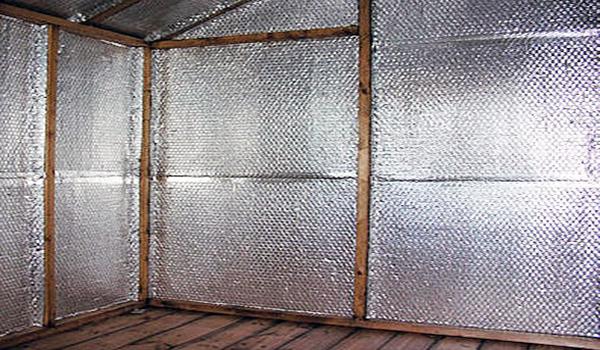
Installation tips
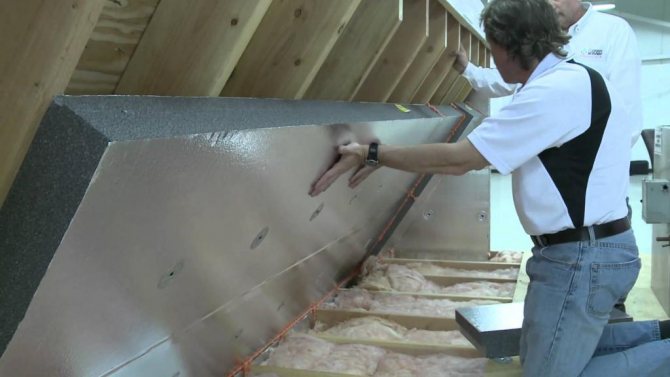

The use of foil insulation allows you to heat-insulate the floor, walls and pipelines for various purposes. Great efficiency can be achieved with its help by insulating entrance doors and verandas. Before fixing the foil polystyrene foam, you must prepare some tools and materials:
- nails;
- a hammer;
- construction stapler;
- nail puller;
- foil insulation;
- construction tape.
The head of the nail can be quite large, which is even desirable. It is important to lay the material correctly with the reflective side facing inward. This will achieve a reflective effect when the heat radiation returns to the room. If you put the insulation on the other side, you will not be able to achieve the expected effect.
We insulate the bath
Baths and saunas are places where you especially need to keep warm. The whole difficulty in insulating these premises is that they have high humidity. Ordinary insulation will very quickly absorb moisture and cease to retain heat, which is pretty bad. But this problem can be solved. There is a special foil for baths, which is used to cover the walls and ceilings. Moreover, the foil can be used without the insulation itself, because the heat will be reflected by its surface. This is called the thermos effect.
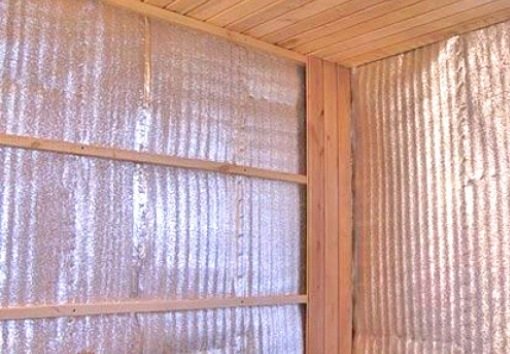

You need to think about insulating your home even at the stage of its construction, because this will help you save most of your energy resources. But what your insulation will be, you must decide for yourself. Also, it will not be superfluous to consult with specialists who can analyze the place of insulation and choose a decent insulation for you.
Back to content
Material handling tips
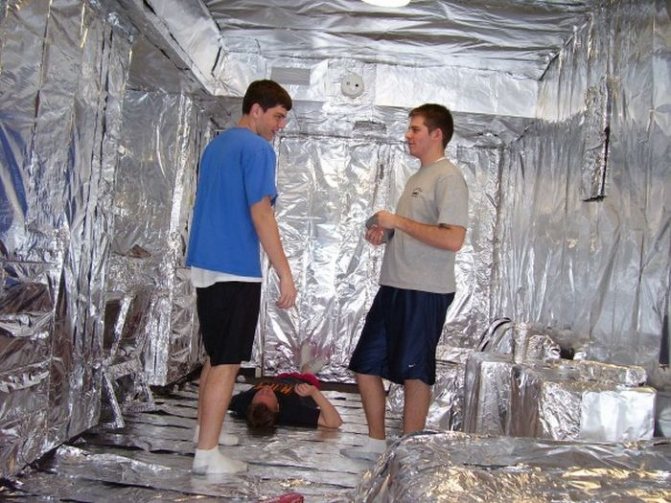

Between the foil insulation and the finish, when installing the first, it is necessary to leave about 2 cm of free space. So, the room will be even warmer. The air will act as an additional insulator, and the structure will work on the principle of a thermos. It is advisable to enclose the material in a wooden crate when laying the material.
Sheets are never overlapped if you cut them from the roll or individual slabs. Installation must be carried out end-to-end, fixing the canvases with nails or a stapler. Foil polystyrene foam can have a self-adhesive layer, therefore, it is not necessary to additionally fix the insulation. But to ensure durability, it is better not to forget about nails.
If the material lacks an adhesive coating, rubber or acrylic glue can be used for attachment. Its application is carried out pointwise. As soon as all the sheets are laid in their places and fixed, the joints must be glued with foil tape. At this, we can consider that the installation is complete.
If you decide to use foil polystyrene foam for the walls, then you need to rid the base of mold.The surface is cleaned before gluing the thermal insulation, otherwise the fixation will be fragile. Among other things, the walls are treated with an antiseptic.
How walls are insulated with a foil heat insulator
To do this, you will need the following materials and tools:
- insulation with foil;
- construction stapler;
- small nails;
- a hammer;
- foil tape;
- wooden slats;
- dowels.
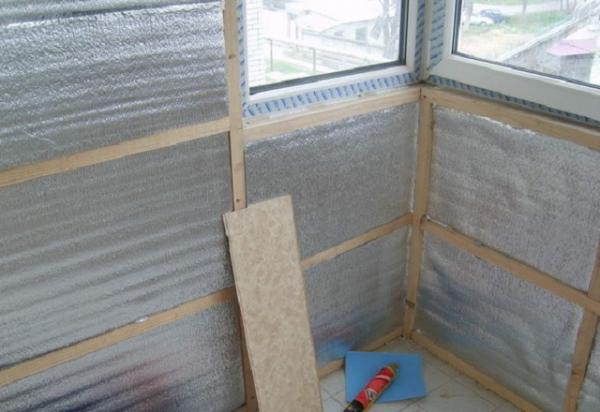

Foil insulation on the balcony
The process of insulating apartments and houses is somewhat different. On the walls of a private house, you need to stuff slats for more convenient installation of insulation. This creates a ventilation space between the thermal insulation layer and the outer wall. The slats are mounted using dowels with a step of about one meter. The material is overlapped and attached to the slats. Foil insulation is best fixed with self-tapping screws or construction brackets. The joints are glued with foil double-sided tape. Penofol is placed with a foil surface inside, then drywall is attached to it. If you decide to get rid of the gap between the insulation and the wall, additional slats are placed before installing the foam foam, to which the drywall is fixed.
This material can be used not only for insulating private houses, but also for insulating walls in apartments, especially if the room is high and it is impossible to insulate the walls from the outside. Another case requiring the use of internal insulation with penofol is the presence of unheated rooms behind the wall, an elevator shaft or a corridor. Check the walls for cracks and cracks before starting work. If they are found, they need to be eliminated. The walls in apartments are insulated in the same way as in private houses.
It is possible to insulate with a foil heat insulator not only living quarters, but also garages, baths, and balconies.
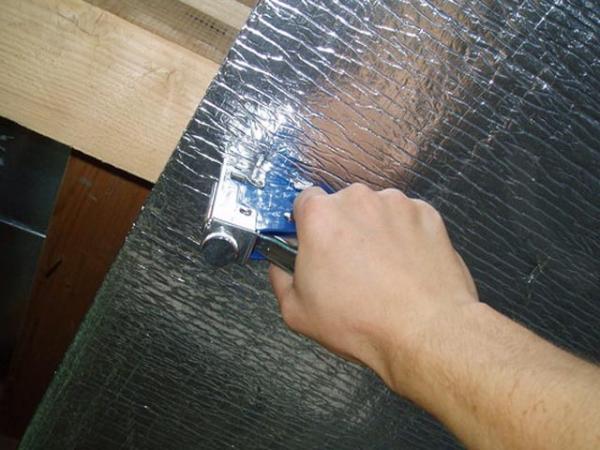

Foil insulation is attached with a construction stapler
At the first stage, such rooms must be rid of excess moisture. Then the walls are cleaned and leveled. Balcony insulation usually starts from the corner. The first layer is waterproofing. Then you can start laying penofol. All seams in the waterproofing layer must be sealed with polyurethane foam. With the help of special glue, the insulation is attached to the wall.
Dowels will help to make the mount more reliable. In this case, it is not recommended to overlap the material, this will reduce the heat-saving properties. It must be laid end-to-end, the seams must be sealed with foil tape. The walls of the verandas are insulated in the same way.
Manufacturers overview
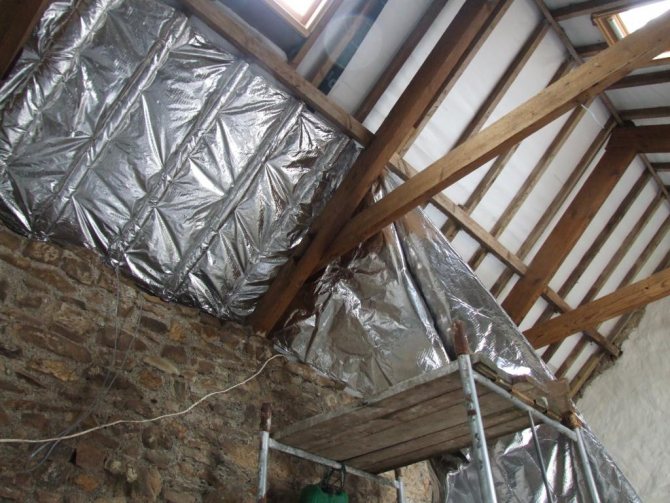

After examining the photo of foil polystyrene foam, you can understand how this material looks. But before you go to the store to buy insulation, you should familiarize yourself with the main manufacturers. Among others, the most popular in Russia should be highlighted:
- Folgoizol;
- Penofol;
- Germaflex;
- Isoflex;
- Ekofol;
- Izolon.
The price of the material will depend on the thickness of the polyethylene. For example, for a metallized roll "Jermaflex", the thickness of which is 2 mm, and the area is 50 m², you will pay about 1,680 rubles. This amounts to 33.6 rubles. per m². If the thickness of the mentioned material increases to 10 mm, and the area decreases to 25 mm², then you will have to pay 1692 rubles for insulation, which is equal to 67.7 rubles. per m². If you want to save money, you should pay attention to cheaper options for foamed polyethylene foil. You can buy them for 18 rubles. per square meter.
Thermal insulation of various structural elements
In frame housing construction, it is advisable to use reflective insulation for thermal insulation of the floor. It is better to mount "breathing" mineral wool on the walls without a foil layer, otherwise air exchange into the room will be difficult.The technology of fastening materials depends on the scope of its application: inside the house, insulation of the roof, floor or pipelines.
Wall insulation with Penofol or Penoflex
The difference between the materials is in the thermal insulation substrate. In Penofol it is foamed polyethylene foam, and in Penoflex it is extruded polystyrene foam. The technical characteristics and the method of their installation are similar.
Useful: do-it-yourself SIP panels: manufacturing technology
Sequence of work:
- According to the dimensions of the purchased insulation (roll width), fill a wooden frame on the walls. The slats are fixed with dowels, the maximum distance is 1 m.
- Cut Penofol - cut into pieces, the length of which corresponds to the height of the room with allowances of 8-10 cm on each side.
- Attach the roll material to the wall, straighten it and attach it to the wooden slats with a construction stapler. Penofol should not hang down or be overly stretched.
- Fill a crate of bars with a thickness of about 2 cm over the insulation. This will provide the required ventilated gap.
Such insulation is perfect for walls in the country., glazed balcony, utility room or animal housing.
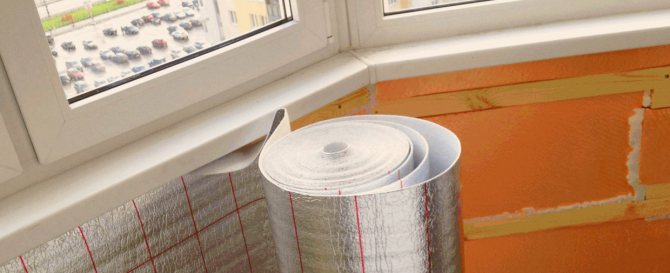

Thermal insulation of the roof with three-layer insulation
Thin roll insulation is not enough for the roof. Penofol is best used in combination with mineral wool, an alternative option is thermal insulation with foil mats made of basalt wool.
Briefing on the installation of insulation with two metallized layers:
- Lay waterproofing on top of the rafters horizontally. The canvases are fastened with an overlap in the direction from bottom to top.
- Press the hydro-barrier to the beams with counter-lattice strips. Next, they need to fill the horizontal bars of the main crate. From above, the installation of the roofing will be carried out.
- From the inside, attach strips with a thickness of 50-60 cm to the rafters, the installation step is 60 cm.
- "Shoot" a three-layer penofol to the formed frame, cover the seams with aluminum tape.
When attaching the inner lining, an air pocket must be provided. Ceilings are insulated according to a similar principle.
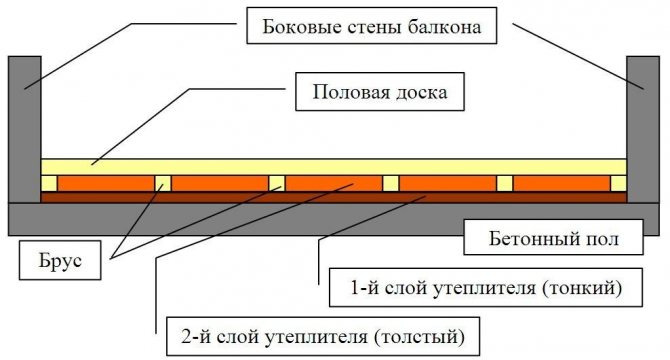

If Penofol is mounted in tandem with additional insulation, for example, mineral wool, then one metallized layer is enough.
Overview of "Penofol" type B
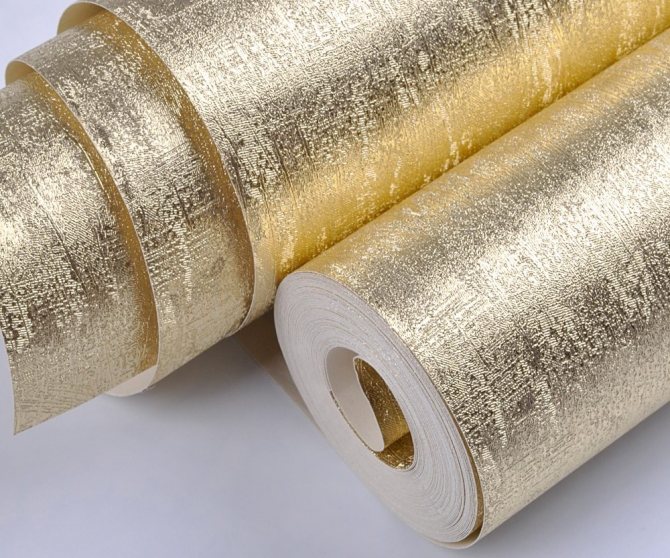

If you want to purchase foil polystyrene foam with double-sided foil, you should pay attention to the material from. It is produced in the form of rolls and is covered with aluminum foil on both sides. Insulation is used for internal insulation of rooms, loggias and roofs.
You can keep warm or cold indoors in winter or summer with an extra layer of foil. This material is blue in color and is based on closed cell polyethylene. The operating temperature varies widely from -60 ° C to + 100 ° C. The surface optical reflectance is 90% and the thermal reflectance is 97%.
Types and characteristics of reflective insulation
Foil insulation is a combined material consisting of a heat-insulating substrate and a reflective layer. The elements are tightly connected to each other by thermal welding. The reflective layer is a metallized lavsan film or aluminum foil. Substrate - various options for insulation that endow the material with certain qualities.
Penofol - foamed polyethylene foam
Roll insulation combining the thermal efficiency of polyethylene foam with the thermal reflectivity of aluminum. The unique product retains heat at three stages of propagation: convection, heat conduction and radiation. Penofol is made of different thicknesses, with one- or two-sided foil.
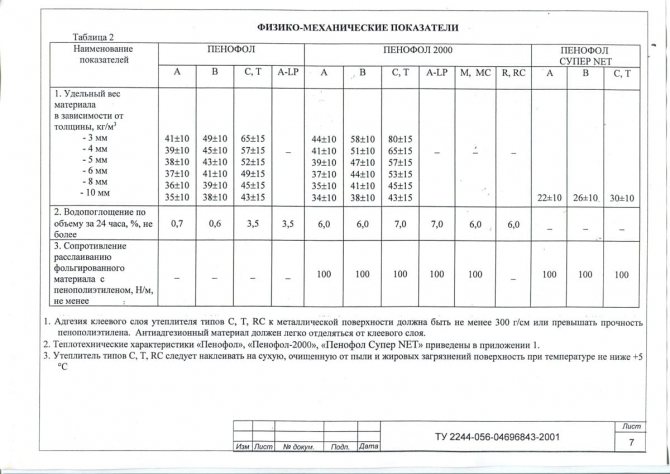

Characteristics of one-way reflective polyethylene foam:
- thermal conductivity - 0.037-0.049 W / m ° C;
- water absorption - 0.7%;
- vapor permeability - 0.001 mg / m * h * Pa;
- compressive strength - 0.035 MPa;
- heat capacity - 1.95 J / kg ° С;
- thickness - 3-10 mm.
Rolled reflective insulation is in demand when arranging a warm floor, warming steam baths, as a finishing substrate for linoleum or laminate. Penofol with a thickness of over 5 mm is used for thermal insulation of balconies, for sewer and ventilation pipes.
Mineral wool insulation
The thermal efficiency of mineral wool increases markedly after foiling. Double-layer insulation is endowed with an additional advantage - the protection of mineral wool insulation from water vapor and moisture. The final characteristics and scope of the material depend on the form of release of the reflective material.
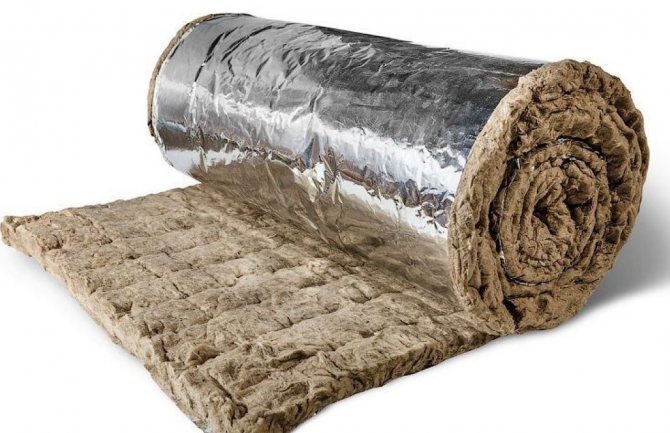

Possible options:
- Roll insulation. The thermal conductivity coefficient is 0.04-0.041 W / m ° C, the thickness of the products is 20-100 mm. Rolls are supplied in lengths of 5-12 m. The density of the insulation depends on the technology of its manufacture. The Isover company offers a canvas with a density of 11 kg / m3, Knauf - 36 kg / m3.
- Sectional slabs. The thermal conductivity of the mats is 0.036-0.039 W / m ° C, the thickness is 50-100 m, the density is 32-40 kg / m3. Decent options: Rockwool Sauna Butts, a Paroc product.
- Cylinders and half-cylinders. Insulation materials for special purposes - thermal insulation of pipelines. "Warm sleeves" are made with one-sided outer foil.
Rolled and slab materials based on mineral wool are optimal for saunas - insulation of ceilings and walls. Due to its resistance to high temperatures, foil wool can be used to insulate boilers, boilers and other storage tanks.
Expanded polystyrene with reflective coating
Durable thermoplastic made by fusing polystyrene granules. One side of the thermal insulator is covered with aluminum foil.
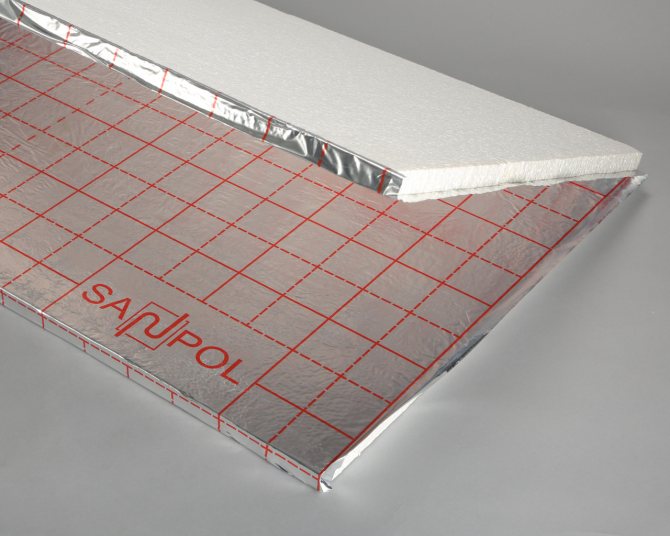

There are two possible forms of release of foil-clad polystyrene foam:
- single mats - slabs of different sizes with a metallized coating on one side;
- sectional rolls - expanded polystyrene inserts are placed on the foil film.
Reflective insulation perfectly resists mechanical stress and high humidity. The material does not grow moldy, does not rot, is not afraid of pests. Foil insulation retains its properties in the temperature range from + 180 ° C to -180 ° C.
Useful: Hood in the kitchen: installation features
Specifications:
- thermal conductivity - 0.035 W / m ° С;
- density - 40-45 kg / m3;
- vapor permeability coefficient - 0.05 mg / mchPa;
- thickness - up to 200 mm.
Most often, foil polystyrene foam is used for underfloor heating.. An aluminum reflector redirects heat fluxes upward to heat the finished floor covering. Achieved savings in heating costs - energy is not wasted on heating the sub-floor and floor slabs.
To facilitate installation, many manufacturers apply markings to the heat insulator - lines to fix the underfloor heating system.
Overview of extruded polystyrene foam from the manufacturer Ruspanel
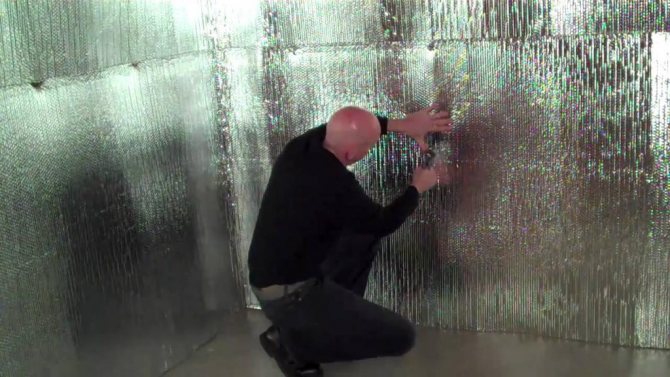

This is extruded foil-clad polystyrene foam, which is produced in a wide range of thicknesses. The latter parameter can vary from 10 to 100 mm. Insulation is used for interior partitions, interfloor ceilings, operated roofs, flooring, ceilings, baths, saunas, heating systems, refrigeration chambers and vans. It manifests itself perfectly in the formation of heat-reflecting layers of heating devices.
This foamed polystyrene foam for a bath provides a reflection of 97%, which allows you to protect the room and perfectly insulate it. The material is lightweight, which makes it easy to transport, ease the installation process and reduce shipping costs. With this material you can save on heating costs and get a constant reflection coefficient.
The insulation provides 100% waterproofing, does not absorb or let water through.The panels are environmentally friendly, they do not contain harmful substances, so they can be safely used to decorate rooms for various purposes.
Expanded polystyrene for underfloor heating installation: 7 advantages of foil-clad material
Expanded polystyrene for a warm floor performs a heat-insulating function, while preventing heat leakage to heating the floor From time to time they forgot about him, then again he was in favor. Now - this material is popular again.
Heat-resistant foil polystyrene foam
First you need to figure out what the expanded polystyrene is - it is expanded polystyrene. It is made on special equipment, and it is quite simple that this building material itself is a cheap and affordable heat-insulating material.
Often polystyrene foam is also called polystyrene. In fact, these are the same polystyrene foam materials, with almost the same physical and chemical properties, but there are still differences.
All these building materials are insulation materials that are actively used in construction or renovation. But we will consider each material separately, realizing that there is a difference between them. Expanded polystyrene (this material is often called polystyrene) is not an official name. What is foam - it is the same polystyrene material as foam. Expanded polystyrene or polystyrene foam is expanded polystyrene, but without the use of pressing. In other words, the cells inside the material remain large and the density is low. The material is very fragile and breaks easily in hands. But it is very light and convenient and is needed in work - it can be easily cut with a knife. An excellent heat insulator, but this material is not suitable for floor insulation. It is often used when transporting fragile materials - household appliances, glass, mirrors, as well as when transporting long distances. Available in the form of plates or in the form of crumbs.
The main advantage of foil polystyrene foam is the environmental friendliness of the material
Recently, a novelty has appeared on sale - foil polystyrene foam. This is the same styrofoam, but covered with metal foil. It is produced in the form of a roll of 5 m long, 1 m wide and about 3 cm thick. The price is set for 1 m2, useful for installing a water-heated floor. The metal foil backing works to shield the heat that is emitted by the underfloor heating screed.
Advantages of foamed polystyrene foam:
- Heat insulator;
- Heat resistant to temperature extremes;
- Excellent sound insulator;
- Non-toxic when heated;
- Moisture resistant;
- Not subject to decay.
A roll of foil-clad expanded polystyrene is spread over the entire area of the room and fastened together with a sealant or a special pecking foil tape. This material has an excellent ability to save energy (heat, electricity). The fact is that 3 cm thick expanded polystyrene replaces 65 cm of brickwork or 125 cm of concrete for thermal insulation.
Styrofoam or polystyrene for the floor: make a choice
It is clear that underfloor heating is when the heating system is hidden under the floor. It should be noted that this system is not a new invention of our designers and builders. Even in the days of Ancient Rome, such a heating system was very popular. But for many centuries it was forgotten and is now remembered about it.
This underfloor heating system is very economical and comfortable for humans. Since the highest air temperature is at the floor surface, and the coldest air accumulates at the ceiling.With the currently adopted heating system - radiators - the air temperature distribution in the room is completely different. With a radiator heating system, the high temperature air is under the ceiling, and the coldest air is near the floor. If the room is still high, then even with good heating, the air near the floor will always be cool.
This is especially true for private houses or ground floor apartments, which are located immediately above cold and damp basements.
Penoplex has a denser structure and weighs more in comparison with foam
Heat-insulated floor is electric and water. The coolant in water is hot water, which flows through flexible pipes under the floor and heats the floor itself and the room. The water heating source can be a gas boiler. Such floors are most often arranged in private houses, since in apartments of multi-storey buildings, the device of such a system is extremely problematic, due to the possible breakthrough of pipes under the floor and further flooding of neighbors or the basement.
Technology for installing a water-heated floor:
- Floor cleaning - removing the old floor covering, removing the old screed;
- Rough screed device and leveling the floor with cement-sand mortar;
- After the rough screed has dried - laying the waterproofing film;
- The damper tape around the room is a heat insulator and compensates for thermal expansion.
Installation is simple, as the tape looks like a wide tape, it is simply glued. Installation of a heat insulator on bituminous mastic must be done with foam plates or foil-clad polystyrene foam can be chosen. Next, flexible heating pipes need to be fastened with special clips. The heating system must be connected to the boiler and the system must be tested - put hot water into the system. On top of the pipe, it is necessary to fill it with a special screed for underfloor heating. The ready-made cement mixture can be found in a special building materials store, and according to the instructions, prepare a cement screed. The thickness of the cement screed must be at least 4 cm. The screed will be ready only after 1 month. After that, you can glue sheets of plywood, ceramic tiles or lay a special laminate for warm floors. Most often, foam plates are produced in the size of 800x700x45. It should be noted that placing mats or rugs on top is not recommended as the temperature of the floor will decrease and the effectiveness of the floor will be low.
Laying underfloor heating on penoplex
Penoplex is such a rigid foam with grooves, but only denser and very hard. The industry produces penoplex in the form of sheets that are orange. The foam floor is good for installing an electric heat-insulated floor.
The technology of laying a warm floor on penoplex is quite simple and installation of this kind is possible with your own hands
Electric underfloor heating installation technology:
- Rough screed;
- Insulation (penoplex);
- Installation of an electric heating cable, and fixing it to the floor;
- Connection of the cable to the power supply system;
- Heating system testing;
- Filling with a special cement mortar for warm floors;
- Laying ceramic tiles.
It should be noted that an electric heat-insulated floor can be installed not only in private houses, but also in apartments on any floors, if, of course, the power of the electric cable that enters the apartment allows. When installing a warm electric floor, to purchase the necessary heating cables, it is necessary to make calculations. The best option is to get advice from specialists and instruct them to carry out the installation as well.
Economical extruded polystyrene foam for underfloor heating
Extruded polystyrene foam (EPS or extruder) is a novelty among floor insulation materials. What is the difference between extruded polystyrene foam, it is fragile and cannot serve as a sound insulator.This type of Styrofoam is popular, especially with lugs to better anchor pipes or cables. After cable installation, it is the optimal solution with decorative coating and installation of floor tiles. The novelties of the heat insulators market are technoplex and premium foam.
Extruded polystyrene foam is non-toxic when heated, and is also the best heat insulator
Penoplex is the same expanded polystyrene, but pressed. It has a higher density and stability, has smaller cells than expanded polystyrene. And they release it in the form of sheets of rich orange color. In fact, this color is the main visual difference between foam and foam.
The use of expanded polystyrene for underfloor heating (video)
Heat insulators have recently entered our lives, but nowadays, they have become an integral part of technology in construction and repair. Using them is of great benefit.
kitchenremont.ru
Overview of foil insulation from
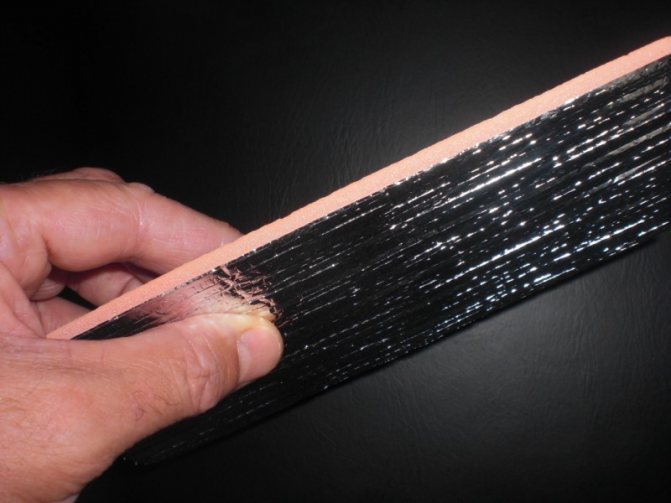

Considering the characteristics of Izolon foil polystyrene foam, you can understand which insulation is better to give preference to. The described material has a low density ranging from 26 to 45 kg / m³. Perfectly reflects heat radiation at 97%. The material absorbs sound well up to 32 dB and above.
Vapor permeability can reach a limit of 0.04 mg / mhPa. The specific heat is 1.95 kJ. You may also be interested in the thickness of Izolon, it reaches 15 mm, while the minimum value is 1 mm. The operating temperature range ranges from -60 ° C to +105 ° C. Foil "Izolon" is often used for heat-insulated floors. This allows the building to be insulated and soundproofed.
Installation is carried out on the floor in one layer. You can use Izolon in conjunction with a dry screed or as a substrate under the floor covering. For such work, it is important to choose the thickness of the insulation. An additional advantage of using foil-clad Izolon is that it is not necessary to use steam and waterproofing together with it, since the material is not afraid of steam and moisture.
foil polystyrene foam for warm water floor
Thermal insulation material (insulation for concrete floors, for example) is the most important component of the entire system of so-called "warm floors". Thermal insulation provides the floor with a special covering that does not allow thermal energy to pass through, saving it inside the room.
Warm floor from expanded polystyrene
In addition, an insulating board is also necessary in order to reduce the load on all heating equipment in the house. The insulation plate does not allow heat energy to "leave" through the ceiling in those areas where heating is not provided.
But what is the most preferable insulation material for such needs?
It just so happened that expanded polystyrene for a warm floor is the material of choice, which will be confirmed by any specialist in insulation. Let's talk about him.
1 Expanded polystyrene and analogues
In general, expanded polystyrene for underfloor heating on infrared underfloor heating is not one specific product. To put it simply, the term "expanded polystyrene" means several types of foam insulation products at once.
That is, both extruded and foil-clad and "classic" expanded polystyrene are used for underfloor heating. And this is important to remember.
All types of foam floor insulation differ from each other not only in appearance, but also, obviously, in technical characteristics. In addition, they differ in the way they are laid.
In addition, you need to know that there are many more thermal insulation materials for non-foam floors. However, they have a number of problems that limit their scope too much.
So cork thermal insulation, like polyethylene pipes in underfloor heating systems, is not available in most cases not at all because of inefficiency.The problem is its huge price, which not every private trader can handle.
Heaters made of so-called "mineral wool" are extremely sensitive to the effects of soil water. For this reason, and only for this reason, thermal insulation mats of this type are not used in floor structures, both on the ground and above the initially unheated underground.
Foamed polyethylene is not used because under the weight of the screed it decreases in thickness exponentially. It turns out that foil-clad polyethylene almost completely loses its effectiveness over time.
Expanded polystyrene for underfloor heating
Granular or extruded foam with lugs is not used because it has a relatively low stiffness.
Although it is worth recognizing that foam with bumps is the cheapest of all the thermal insulation materials described above, moreover, it also has good insulating efficiency.
Precisely because the heat-insulating mats listed above are not quite suitable for creating a warm floor, it is better to use extruded polystyrene foam or its “brothers” (for example, classic foam).
2 Construction scheme
In general, extruded polystyrene foam for floor insulation in a private house has the following construction scheme for creating a warm floor:
- Taking extruded polystyrene foam, then its granules, or evenly cut plates, are used to fill the free space between the floor logs, which are pre-installed on a plank or plywood base;
- On top of the heat-insulating mats are covered with a vapor barrier membrane, after which an additional crate is placed in the cross of the logs, which will serve as a kind of ventilation;
- Plywood or similar sheet material is then placed on the crate;
- Next, the installation of the rails is carried out. Between them, you should put the loops of the warm floor;
- Then everything is done, focusing on the overall budget of the construction work. It is recommended to put 30 µm thick foil along the path of the water floor pipes, or cover the surface of the water floor with foil-clad polyethylene. These are the preferred options.
After laying the foil along the path of the pipes of the water floor, the entire structure should be covered with plywood, or using OSB boards.
A priori, it should be assumed that the structure of the water floor is initially protected by special waterproofing on the side of the underground. If not, it should be organized.
Remember that even despite the fact that manufacturers of such thermal insulation products assure their customers that all materials are pre-protected from moisture, you should not trust this in absolute terms.
In any case, it is important to make forced waterproofing, especially for floor insulation with expanded clay. Otherwise, moisture, having penetrated into the pores of the insulation, over time will significantly reduce the effectiveness of the insulation or completely destroy the structure of the insulation material.
The internal structure of the warm floor
In addition, it is also recommended from the basement side to additionally protect the thermal insulation material with a small small metal mesh from all sorts of rodents. In some buildings, they are a real scourge.
Their ability to destroy thermal insulation is simply amazing. Therefore, such protection is not so much recommended as simply necessary.
2.1 Pros of expanded polystyrene
The polystyrene foam backing is good in that this material provides its effective insulation. Insulation mats made of expanded polystyrene are simply ideal for creating a warm floor with both density and strength and, including rigidity.
The reason for this is how EPS insulation mats are made.Briefly, the whole process looks like this using a calculator for calculating the thermal insulation of pipelines:
- The material polystyrene, or one of its derivatives, is foamed using a special method (introducing a low-boiling liquid into the initial mass of polystyrene);
- In the process of boiling, a kind of granules clothed with a waterproof surface are formed. There is gas inside them, which determines the lightness and thermal insulation characteristics of the material;
- The product is heated with steam in order to increase the amount of small pellets. They increase them tenfold, but sometimes they reach thirtyfold increase;
- In the end, the enlarged granules join together and form insulation mats with small, but numerous and sufficiently strong cells.
Thermal insulation mats made of expanded polystyrene at the outlet have the properties that were predetermined by the method of "sintering" the granules.
The resulting foam backing (board) is presented to the consumer in a huge number of multi-colored design options. At the same time, the substrate, no matter what design it has, does not change its performance indicators from this.
Installation of insulated floor
The thermal underlay is now ready for use. You can lay it in the following ways and under the following conditions:
- On the soil with preliminary compaction, backfilling with ordinary gravel and a ten centimeter sand layer;
- On a concrete floor, which is pre-covered with a polyethylene coating of 0.2 millimeters;
- On wooden beams, which are pre-covered with either polyethylene or glassine.
It should be understood that only a heat-insulating substrate is suitable for creating a warm floor. Whereas bituminous mastics or materials containing solvents are strictly prohibited.
They not only destroy the entire structure, but also gradually dissolve the expanded polystyrene itself and the Izospan windproof membranes. Therefore, you should remember: only a heat-insulating substrate is suitable.
It is possible to install rigid polystyrene foam slabs, including on compacted gravel. But here it is important to remember that in any situation, the insulation must be additionally protected from moisture and, in addition, cut off from the walls.
This is necessary in order to prevent the transfer of thermal energy and sound vibrations (heat insulation and sound insulation come out in one package).
2.2 Tips for installing underfloor heating insulation (video)
uteplimvse.ru
Izolon installation tips
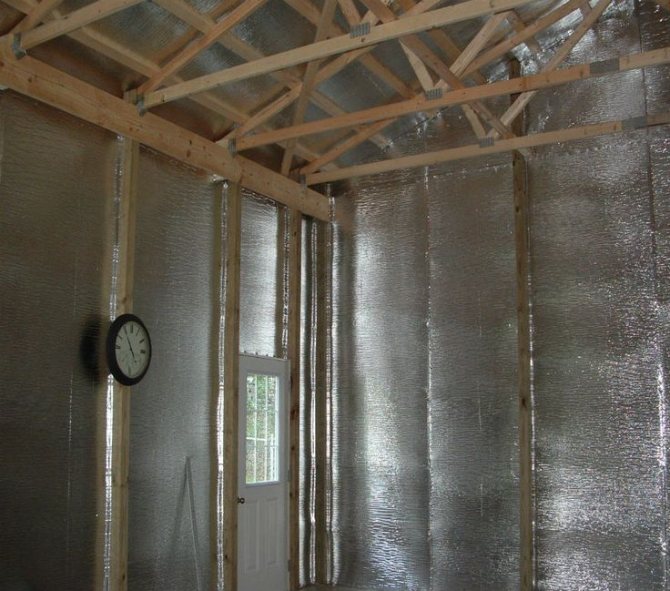

Foil "Izolon" is laid between the finish and the wall, while it is necessary to form an air gap. For this, wooden slats are stuffed onto which Izolon is attached with small nails. All joints should be glued with aluminum tape.
For such work, a material covered with foil on both sides is best suited. When insulating concrete floors, it is better to use a different material, placing it between the floor joists. After that, the insulation is laid on the base coat.
Quite often Izolon is used as a substrate for laminate flooring. If you decide to use the material when insulating a balcony, then it is better to resort to multi-layer installation. Izolon was the first to fit. Its installation is carried out in such a way that the reflection is external. After that, the foam should be laid, then the Izolon layer is applied again. At the next stage, a crate is installed on which finishing materials will be attached.
Installation technology
In the case of installing mineral or basalt wool, you will also need a respirator, goggles, gloves and other personal protective equipment against the ingress of its small fragments into the body.
Materials:
- insulation;
- glue;
- masking tape / regular or foil tape;
- screws with plastic dowels;
- nails;
- polyurethane foam;
Instruments:
- knife;
- screwdriver;
- a hammer;
Stages of work:
- All types of insulation are mounted on a dry surface cleaned of any dirt with sealed cracks. Expanded polystyrene plates, in addition to all this, also need smooth walls. To do this, they should be leveled with plaster, and after it has completely dried (3-4 days), sanded.
- For the installation of mineral or basalt wool, a frame made of wooden or metal slats is arranged in the room, the rest of the heaters are mounted directly on the walls. If it is self-adhesive polyethylene, then the protective film is carefully removed from it, the material is straightened along the surface of the wall, while blistering and the presence of air bubbles under the insulation should be avoided.
- It is better to mount polystyrene foam at the same time on glue and screws. The glue is applied to the entire surface of the sheet, or partially - in large spots or wide stripes. Screws are screwed in in the amount of 4 pieces per square meter. Insulation sheets are mounted from bottom to top and staggered.
- Polystyrene insulation is usually then plastered and painted or sheathed with siding or wood panels.
- All types of foil-clad insulation are mounted joint to joint, the gaps are glued with foil tape, or sealed with polyurethane foam or heat-insulating mastic.
If the material has an adhesive base, then additional fastening means are not needed. For expanded polystyrene, glue or screws are used, roll insulation is attached with small nails, or it is also set on glue. Minvata usually just fits tightly between the frame slats.
Advice
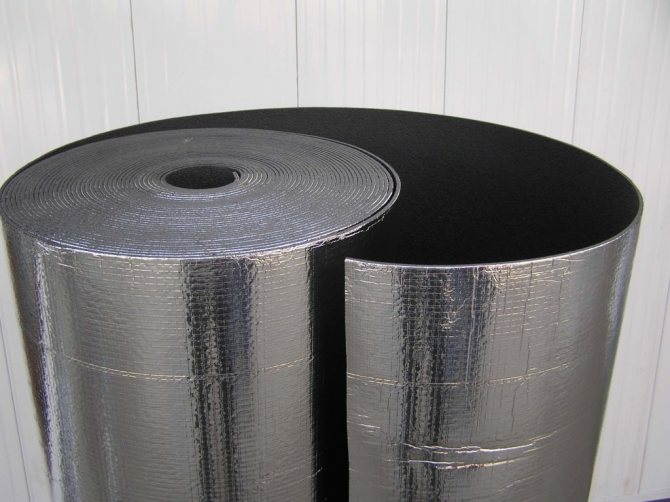

- You can attach a piece of foil insulation to the space behind the batteryso that the heat from it does not go into the wall, but is reflected back into the room.
- When working with foil-clad polyethylene care should be taken as the material tears easily even with your hands.
- To achieve maximum thermal insulation it is recommended to leave an air space of 1.5 - 2 cm between the insulation and the finishing of the room.
- If the insulation has only one foil side, it should face the inside of the room.
- You should not save on materials for insulation. Heating a cold house or changing the insulation will cost more than spending a single time on quality material.
- Any material should "get used" to the microclimate of the room, for this he must be allowed to rest for at least a few hours.
- Calculate the required material thickness simple formulas in regulatory documents will help.

